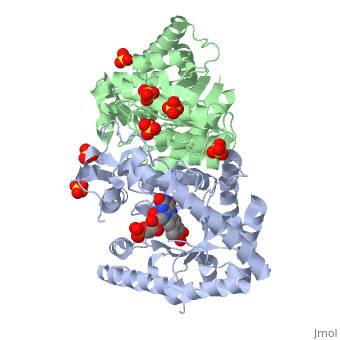User:Mitchell Long/Sandbox 1
IntroductionLuciferases are a class of enzymes that catalyze the oxidation of a long chain aliphatic aldehydes. This reaction results in the formation of a carboxylic acid and the emission of photons in the form of blue-green light. The luciferase found in 'Vibrio harveyi' is a heterodimer that is composed of a catalytic α subunit and a homologous but noncatalytic β subunit. The catalytic α subunit houses the FMN cofactor and is connected to the β subunit via a hairpin structure called the "mobile loop."
MechanismLuciferase found inV. Harveyi binds noncovalently to a reduced flavin mononucleotide cofactor, an aliphatic aldehyde and oxygen to yield oxidized flavin mononucleotide, water, and carboxylic acid. The reaction occurs in two steps forming a hydroxyflavin intermediate and ultimately results in the oxidation of the aldehyde and emission of photons in the form of blue green light. FMNH2+O2+RCHO→FMN+RCOOH+H2O+hv(490nm) The catalytic α subunit houses the FMN cofactor and is connected to the β subunit via a hairpin structure called the "." The organic substrate for bacterial luciferase in vivo is myristic aldehyde, although many aliphatic aldehydes of various lengths can induce bioluminescence in vitro.
Structural MotifsStructure homology-There is a great deal of sequence homology and structural coservation between the α and β subunits. When superimposed over eachother the barrels of the alpha and beta subunits with a deviation of 0.62Å for 42 equivalent α carbons. The region of the beta subunit that contains the 29 residue deletion with respect to the alpha subunit differs notably in arrangement. In the alpha subunit, the α7a helix is straight and extends toward the beta subunit. The region involved with dimerization, helices α and β and the hairpin loop structure are exceptionally similar in superposition. Active Site and Alpha Subunit-the of bacterial luciferase is a large open cavity that is accessible to solvent via an opening located at the C-terminal ends of the ǰ strans of the TIM-barrel structure. During the first step of the oxidation reaction, FMNH2 binds to the flavin binding pocket and the enzyme undergoes a conformational change that blocks water in the surrounding environment from accessing both the excited peroxydihydroflavin intermediate. Next O2 and a long chain aldehyde bind to the FMNH2 luciferase complex and a two step oxidatino reaction occurs. .
The β subunit-The beta subunit is characterized as a necessary but non-catalytic subunit that stabilizes the catalytic ǯ subunit that is responsible for the oxidation reaction. Both subunits share a great deal of homology
Mobile Loop- Phe2772-thr 288 (β/α)8 Barrel- The tertiary structure of the α and β subunits is very similar. both subunits fold into a single-domain eight-stranded β/α barrel motif. the two subunits assemble around a parallel four-helix bundle centered on a pseudo 2-fold axis that relates the alpha and beta subunits. . |
| ||||||||||
| |||||||||
| 3fgc, resolution 2.30Å () | |||||||||
|---|---|---|---|---|---|---|---|---|---|
| Ligands: | , , | ||||||||
| Gene: | luxA (Vibrio harveyi), luxB (Vibrio harveyi) | ||||||||
| Activity: | Alkanal monooxygenase (FMN-linked), with EC number 1.14.14.3 | ||||||||
| Related: | 1luc, 1brl | ||||||||
| |||||||||
| |||||||||
| Resources: | FirstGlance, OCA, RCSB, PDBsum | ||||||||
| Coordinates: | save as pdb, mmCIF, xml | ||||||||
Applications In BiotechnologyApplications In Biotechnology
Luciferases are most commonly used as reporter genes by transduction or transfection assays. Reporter genes are inserted into an organism with a gene of interest. This is a powerful method of measuring gene expression because it is non-invasive. Genes for luciferase can paired with an inducible operon. When the gene for luciferase and the gene of interest are incorporated into the host genome, they can "turned on" by induction.
Quorum SensingQuorum Sensing
In a process known as quorum sensing, bacteria communicate using secreted signal molecules called autoinducers(AIs). V. harveyi is a mesophilic, gram negative, rod shaped bacteria that can communicate with other bacteria via quorum sensing. Quorum-sensing bacteria alter gene expression in response to the accumulation of AIs, which reflects an increase in cell population density. This process is believed to provide bacteria a means to coordinately control the gene expression of the group, giving them multicellular characteristics. When bacteria reach a "quorum," their population has reached a density high enough to coordinate gene expression. Often, bacteria make and respond to multiple AIs. Vibrio harveyi, a free-living marine bacterium, produces at least three distinct AIs to control bioluminescence, biofilm formation, Type III Secretion (TTS), and protease production. When a bacterial population density is low, the LuxI gene is transcribed constitutively at basal level. The three V. harveyi AIs are HAI-1, an acyl homoserine lactone; AI-2, a furanosyl-borate-diester; and CAI-1, of unknown structure. When the population density reaches an adequate level, the conjugate receptor LuxR begins transcription. LuxR is the regulatory receptor, and when an AI binds the the LuxR receptor, transcription is turned on resulting in the production of more AI and the expression of other genes involved in quorum sensing. When V. harveyi reaches a high enough population density, it's quorum sensing genes are activated and the transcription of the genes that code for the luciferase enzyme.

